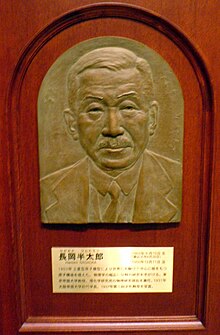Nagaoka Hantaro
Nagaoka Hantarō ( Japanese 長 岡 半 太郎 ; born August 18, 1865 in Ōmura (Nagasaki) , † December 11, 1950 in Tokyo ) was a Japanese physicist .
He first studied mathematics and physics at the University of Tokyo from 1884 , including with the English physicists James Alfred Ewing and Cargill Gilston Knott, who were then teaching there (especially on magnetism). After graduating in 1887, he went to Europe, where he heard from 1893 to 1896 in Berlin with Max Planck , Hermann von Helmholtz and August Kundt and with Ludwig Boltzmann in Vienna and Munich. On his return to Japan in 1896 he became a full professor of theoretical physics at the University of Tokyo. From 1916 he was director of the Physics Institute. His specialty was magnetism, and from 1900 he worked with Kotaro Honda .
In 1904 he developed an early "planetary model" of the atom ( "Saturnian theory" ), which describes the atom as a large, positively charged sphere that is orbited by the negatively charged electrons .
In 1910 he was head of the founding conference (of Japanese foreign students and scientists) of the University of Tōhoku in Paris, which was to be built on the model of the University of Göttingen. From 1916 until his retirement in 1926 Nagaoka was the director of the Physics Institute at the University of Tokyo and at the same time worked at the private research institute Riken (1917-1946). From 1931 to 1934 he was President of Osaka University. From 1939 to 1948 he was President of the Japanese Academy of Sciences.
Nagaoka is considered to be one of the pioneers of physics in Japan, who significantly promoted her connection to the European and American research. He is one of the first to be awarded the newly created Order of Culture by the Emperor in 1937. The theoretical physicist Jun Ishihara is one of his students .
A crater on the moon was named after Nagaoka .
literature
- Wolfgang Stiller Ludwig Boltzmann , Barth 1988
- E. Müller-Hartmann (Editor) History of Physics in Japan , Franz Steiner, Wiesbaden / Stuttgart 1984
Individual evidence
- ^ Date of birth according to Michael Toeppel (Ed.), General Directory of Members of the German Mathematicians Association 1890-1990, Munich 1991
| personal data | |
|---|---|
| SURNAME | Nagaoka, Hantaro |
| ALTERNATIVE NAMES | 長 岡 半 太郎 (Japanese) |
| BRIEF DESCRIPTION | Japanese physicist |
| DATE OF BIRTH | August 18, 1865 |
| PLACE OF BIRTH | Nagasaki |
| DATE OF DEATH | December 11, 1950 |
| Place of death | Tokyo |
